
Did you know that your browser is out of date?
To get the best possible experience using our website we recommend that you upgrade your browser to a newer version. The upgrade to the software below is free.
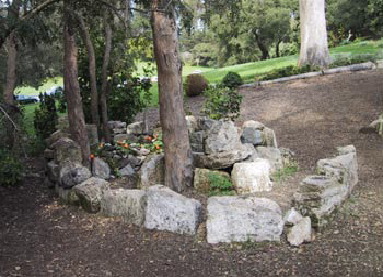


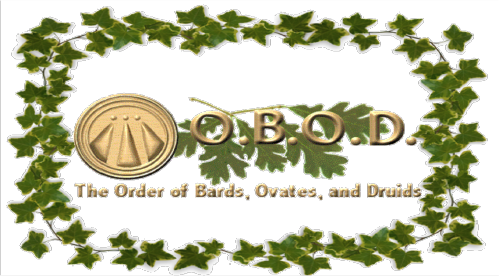
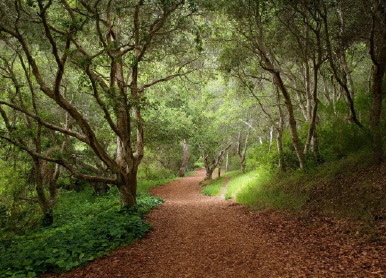
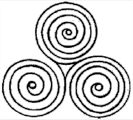

Archetypal Energy: Dark-Solar-Masculine
Archetype: Lugh (Celtic); Hermes/Mercury (Greek and Roman), The solar god who enters the Underworld; The sacrifice of the Corn King “Green Man”
Lughnasadh is the season between July 31 st and September 21 st. Lughnasadh is the season of Lugh, the sun god who distributes riches in the form of crops and wild food. This festival traditionally marks the start of harvesting, and is a time when you can begin to reap the rewards of the ideas that you germinated at Imbolc.
Lughnasadh is a time of the trickster god Hermes. It is a time of the Dark Masculine. Throughout Europe and the Mediterranean in very ancient times, kings were sacrificed at this time. They were sacrificed every seven years and their blood was spilled upon the earth in order to propitiate the fecundity and fertility of the earth. The kings received immortality as a reward for this sacrifice. This tradition is seen in Egypt with the god Osyris who is killed and dismembered and then reborn; this is seen in the northern hemisphere in many bear cults, where a bear as a representative of God was sacrificed and reborn; this is even seen in the Judeo-Christian tradition which follows many other traditions concerning the belief in a divine king, child of God who is sacrificed and killed for his people. In later times Druids and others sacrificed a white bull rather than the king for the fecundity of the earth.
This season is a time to focus upon the sacrifice of the Corn King which is a ritual that substituted the sacrifice of the corn (the corn god). This sacrifice is a necessary step in the process of death, rebirth and transformation. The sacrifice of John Barley Corn (whiskey) has also been a part of this ritual. The ritual of harvesting the corn, grinding it into mash and then fermenting it into whiskey (as with wine) is a metaphor for spiritual and physical transformation. This season is a time to explore what one needs to sacrifice and give up in order to be transformed. This season is a time to explore connection with Hermes who can journey into the underworld and meet the dead. Lugh/Hermes is the psycho-pomp (guide) who leads us at death into the otherworld of the dead. This season is a time when strange and often violent events occur such as September eleventh, the death of Princess Diana, Hurricanes Katrina and Wilma etc. This is the time of the Dark Masculine.
In Celtic tradition gatherings, similar to the Greek’s Olympics occurred. These competitions included athletic, poetic and battle competitions. These were celebrations of first harvest.
Associated energies and symbols for the season of Lughnasadh
1. Associated Element: Water
2. Direction: Southwest
3. Season: Autumn
4. Faery Realm: Murias of the Undines (Mermen andMermaids)
5. Animal: Horse
6. Plant/Tree: Hazel, Celtic: Barley(whiskey);Roman: grape vine (wine)
7. Color: Orange
8. Earthly Realm: Plant
9. Arch Angel: Gabriel
10. Polarity: Masculine/Receptive
11. Energy: Dark/Negative(-)/Lunar
12. Focus: Inner/Introverted
13. Sacred Tool: Chalice/Cup/Holy Grail (Celtic)
14. Stage of Life: Mature Adulthood/Midlife
15. Time of Day/Night: Dusk
16. Body Consciousness/Chakra: Genitals(Celtic);Solar Plexis(Hindu)
17. Consciousness: Lunar
18. Jungian Personality Function: Emotion/Feeling
It occurs around August 1 and celebrates the birthday of the god Lugh. Lugh is the Celtic pychopomp. The pyschopomp is a god or energy or force that bridges between light and darkness; it is the energy that leads those who have died from the world of living into the world of darkness. It is a bridging energy of light that can enter darkness. Lughnassadh is a time of celebration of first harvest. It was a time to celebrate achievement, heroism, artistic abilities. It was a time of Olympic game and performances and events, harvest festivals. Lugh is also a god of the arts and artistic abilities. It is a good time to focus on one's creative skills, prowess, performance and abilities. It is time of the grain goddess. Time of sacrificial king in which sacrifices were made to propitiate the fecundity of the earth and give thanks to the harvest.
It is a time of birth and beginning of the underworld earth god. We would also celebrate our talents and ego by boasting our qualities and attributes and performing poems, dance, or any other artistic expressions within the circle. This practice is called Eistedfodd in the Welsh laguage and tradtion. This is the time of bardic contest involving poetry, music, and art. While Esitenfodd maybe a part of all other celtic festivals, it is especially associated with Lughnassadh. First harvest of grain food products would be shared, like corn bread. In many Catholic traditions, the same festival is known as Lammas. In some Catholic folk tradtions, loaves of bread are offered as symbolic sacrifice as the first grain of the harvest.
Personal focus:
The focus of Lughnasad is what one needs to sacrifice in order to achieve our intentions in our life. This may include focusing upon addictive or compulsive habits which must be let go of; toxic and dysfunctional relationships; co dependency etc. In order for change to occur in one’s life one must be willing to sacrifice and make room for change. Chaos involving the breakdown and elimination of comfortable structures must be embraced. Hermes is the god of chaos and change. These changes may be painful, chaotic and filled with surprises for a person.
This is also a time to focus on dark or masculine traits such as boasting, competition, and aggressiveness as well as being wily like the fox. Our ritual at Monarch Bear Hill will focus upon the sacrifice of the Corn King in order to propitiate our year’s harvest.
Ritual for Lughnasad
The ritual is celebrated in the Monarch Bear Grove in the solar Celtic cross circle. Primary focus is giving thanks to the first harvest. Second is the focus upon sacrifices: what we need to sacrifice in our lives in order to create the life we want to have. We might write down things we want to give up, like addictions, bad relationships, and burn them in the cauldron in the center. We also do some rituals to symbolize the sacrifice of the solar king, which could include pouring of wine on the earth, spreading corn seeds around the sacred grove, representing the sacrifice of the corn king/god. Lughnassadh is the time when the solar king, who achieves his most powerful energy at the time of summer solstice, begins to wane and lose his power.
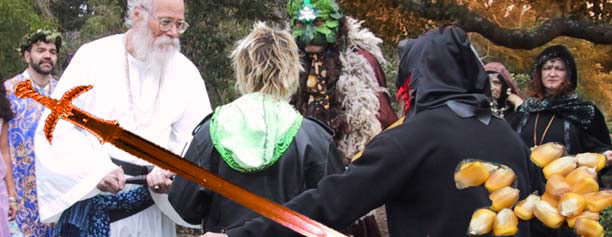
The 8 Seasons of the Celtic Wheel of the Year
In Celtic Shamanistic Traditions, each of the different directions has different elemental and energetic and behavioral associations.
Begining about Nov. 1st -- Samhain is the Pagan New Year. It literally means "summer's end" in Irish Gaelic, and is the hallmark of the feminine half of the year. It is the time we honor those beloved who have died, particularly in the last year.
Yule is the celebration of the rebirth of light. It is humanity's oldest celebration which honors the Goddess giving birth to her son - the God, the Sun, and the Light.
February 1st - Brighid honors the time just before spring, when the earth is preparing to burst forth in productivity. It is the time when ewe's milk begins to flow in preparation for birthing, a symbol of the mother's milk of the earth.
Marks the shift from the lethargy and darkness of winter into the fruitfulness of Spring. The festival honors the time for new beginnings, as we travel into the light and action of spring, in gratitude for its warmth and light.
May 1st - Beltaine is the hallmark of the male part of the year, and honors the fecundity of earth. The God and Goddess are in sexual union - the maypole represents the phallus of the God planted in the Earth Goddess. The plants and flowers we lash to the maypole with ribbons represent the fertility of the Goddess. The festival celebrates vitality and passion - we cherish the joys life has to offer.
A festival in honor of the sun, of passion, and of the ripeness of the earth. The Goddess and the earth are heavy with pregnancy. This is a time when sacred and magical plants are gathered, dried, and stored for the coming winter.
August 1st - A time of thansgiving for the first fruits of the harvest. The God, a metaphor for the grain, is sacrificed - cut down in the fields to feed us. We make offerings of gratitude, ever mindful of the bounty the earth provides.
The light and darkness again are equal, but light grows less. The God, sacrificed in the harvest to nurture us, begins his journey into the Underworld. Mabon is a celebration of the completion of the harvest begun at Lughnasadh.